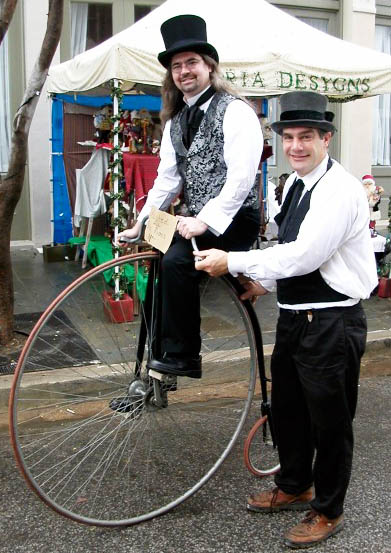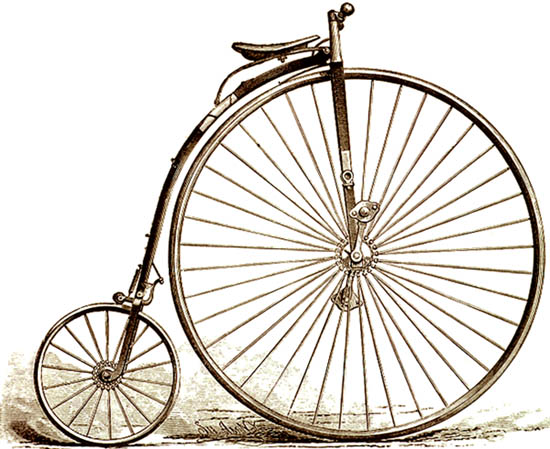The High-Wheeler
Today, the brief day of the the high-wheeler. The University of Houston's College of Engineering presents this series about the machines that make our civilization run, and the people whose ingenuity created them.
I've been reading David Herlihy's book, Bicycle: The History, and I'm drawn to the high-wheelers. Those were the bicycles with the huge front wheel and the small back one. You may've heard them called Penny Farthings because the big and little wheels look like those old English coins, laid side by side.
But let's back up for a moment: Evolution of the modern bicycle began when German inventor Karl von Drais unveiled his velocipede in 1817. It was a two-wheeled aid to walking with a saddle and no pedals. The word bicycle was coined after commercial velocipedes were equipped with front wheel pedals, around 1867. Less than twenty years later, the bicycle found its present form with a chain driving the rear wheel -- the so-called safety bicycle.
But, in that interval after the first pedaled bicycles appeared, it became clear that each rotation of the pedaled wheel would carry the rider farther if the diameter of the pedaled wheel were increased. The high-wheeler era began after pedaled front wheels appeared, and it ended with the safety bicycle. By the mid-1870s, front wheels had become nearly as tall as riders themselves.
Mounting a high-wheeler was an athletic feat. One ran down the road with the bike, then swung one leg over the wheel and made a running leap into the saddle. Makers finally added a step over the back wheel. That helped; but then the rider had to catch the whirling pedals with his feet to gain control of the machine.
No matter, this was heady stuff. The high-wheeler caught on. Bicycle clubs and bicycle races drew people in. Cyclists first conquered the four-minute mile. Then they cut that down to a little over three minutes. They raced horses and often won. Next, endurance trials: A cyclist did fifty miles in four hours; soon after, one did 650 miles in seven days.
Herlihy recounts a telling transaction: An agent of the new Bicycling World magazine scolded the editor of an American encyclopedia who hadn't included an entry under bicycle. The editor told him that bicycles were only toys. The agent shot back, "Is the telephone a toy? Or the Type-Writer? Or the Passenger-elevator?"
Well, what new invention isn't frivolous? What good is a newborn baby? The high-wheeler was not yet the utilitarian machine that everyday people wanted and needed for getting from one place to another. But then modern safety bikes appeared, and they were the bridge between the horse and the automobile. A half century later, my first job was biking drugstore orders to local citizens.
Bikes were then as common as cars. And they've remained so (until now) on the streets of Shanghai and New Delhi. And the newborn babe, from which all that utility sprung, was to be found in that brief bright epoch of the high-wheeler -- that Courier & Ives relic of carefree frivolity, that strange, seemingly unmountable machine that was the prelude to utility.
I'm John Lienhard, at the University of Houston, where we're interested in the way inventive minds work.
D. V. Herlihy, Bicycle: the History. (New Haven, CT: Yale University Press, 2004).

Jason Tibbitts aboard a high-wheeler during Galveston's Dickens on the Strand celebration. (Photo courtesy of Mason Hart)

(clip art)